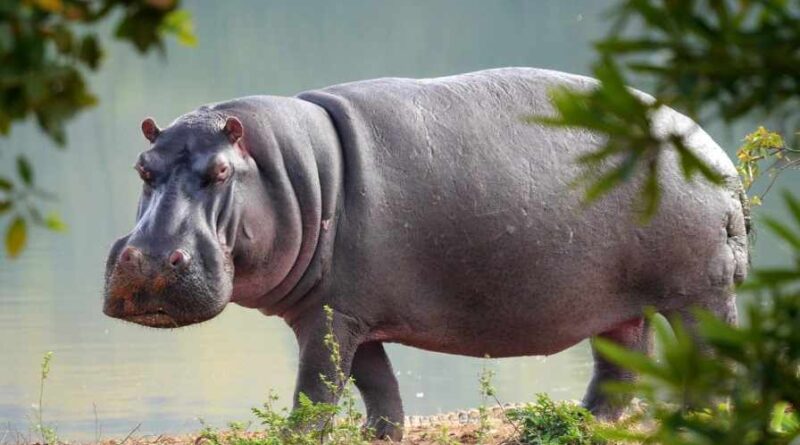HIPPO
Hippos are the largest animals that live in fresh water and are found all over the world. They can be found in the rivers and lakes of tropical Africa. An adult male hippo weighs up to 3,000 kilos. Females are a bit smaller than males. Even though it is very big, the hippo doesn’t eat very much. This is because it is so lazy and doesn’t try very hard very often. It stays in the warm water all day, either floating, sunning itself on mud flats, or slowly swimming under the surface. Its fat, sausage-shaped body floats on the water, so it doesn’t have to do anything to wallow for hours. The most active thing it does most of the time is yawn. It comes out of the water at night and slowly makes its way to the grassy banks of the river, where it eats for five to six hours.
It always waits until well after sunset to make this move, and by the time sunrise comes, it is back in the water where it is safe. Most of the time, by 4 a.m., all the hippos in a group have come back. A hungry one might stay out a little longer, but even they turn around before the first rays of light come over the horizon. Younger animals spend most of their time on land, while older, more powerful males are the last ones out of the river and the first ones back in. Because they protect the group’s territory, they seem to stay in the water a little longer than the others. When on land, the hippo walks carefully along well-worn paths that it knows well and has smoothed and flattened with its short, tree-trunk-like legs.
Some of these paths have been used by hippos for many years, and the younger animals literally walk in the footsteps of their ancestors. Along the sides of these paths are special piles of dung, where the adult hippos leave their own scents as a way to let other animals know they are there. Each hippo travels a few miles at night, and sometimes up to 15 miles if they need to find food. After it has eaten all the grass stems it can eat with its 50-centimeter-wide lips and eaten any fallen fruit it was lucky enough to find, it plods back down the same familiar paths and into the water to get ready for another busy day of sleeping. It sounds like the hippo’s life is calm and easy, but there are times when it can become violent and loud.
This happens when two male hippos argue about who owns a certain part of the river. Each male has a set area that he rules over. There, he lives with his wives and their females. No other males are allowed in his space. If they do, they will be challenged right away, and a terrible battle will start. It could go on for more than an hour before one male, usually the owner of the patch, scares the intruder away. Bluffing and counter-bluffing are the first steps in hippo fights. Males don’t attack each other right away when they’re mad.
There are other things to show besides actual contact. Before they charge and bite, they do a lot of different things to show that they are ready. Most of the time, these displays are enough to show who is in charge. However, if two males are very similar, they will sometimes get into a serious fight to the death. Dunging is the most common way to show off. When two males meet at the border between their two kingdoms, they turn their rumps toward each other and drop their dung on the ground.
The hippo’s tail is flattened like a rudder, which helps it do this in a very impressive way. As they poop, they quickly flick their short, stumpy tail from side to side. This makes sure that the hippo’s waste gets spread as far as possible. It may seem like an odd way to threaten an enemy, but these males’ droppings smell like them, so they can tell each other about their health and how aggressive they are feeling.
If one of the males is brave enough to move onto a rival’s stretch of river, things get worse. Now, the displays are very exciting, with fierce charges forward and spectacular dives through the water. You can hear Loudi grunting, and the males are starting to stand up in the water and splash down again. They might blow water out of their nostrils loudly and throw huge mouthfuls of water into the air.
Eventually, if neither of them will back down, they start fighting with their bodies, hitting each other in the way and body with their scary teeth. At this point, you can make many cuts and slashes, and the skin starts to bleed. The hippo’s skin can heal quickly, so once the fighting is over, these wounds will heal quickly.
At last, one male gives up and bows his head and body. After he leaves, the river is once again at peace, and the hippos can go back to being lazy and sleeping all day. Hippos can sometimes be very dangerous, both to people and to other hippos. Small boats that move into the territory of a particularly aggressive male may be attacked and sunk.
African tribesmen who lived near the big tropical rivers where hippos lived for hundreds of years have hunted these big animals for their meat. They have killed them with both harpoons and spears, often putting their lives in danger to do so. The huge jaws of the animal are very strong. When angry, a hippo has been known to split a man’s body in half with a single bite. Hippos can swim surprisingly fast when they are excited. They do this by moving their heavy legs in a dog-paddle motion. When they move below the surface, they move with surprising grace, unlike when they are on land. The movie “Underwater” showed us how graceful a swimming hippo can be.
Their bodies are made for living in water. Considering the animal’s It can be seen all over the top of the head. The short ears, the ability to close The animal’s nose and big eyes can be brought above the water’s surface, but the rest of its body can’t be seen from the riverbank. When they go all the surface under, they can easily stay there for five minutes, and some people think that if they have to, they can stay down for up to fifteen minutes. Some people even say they can do it in half an hour or less, but that’s not true. As aquatic animals, they can’t handle fast currents, so they have to stay in water that moves slowly. If they go into the rapids, it’s easy for them to get swept away and thrown down the river, far from their home territories. Hippos have been swept out to sea on rare occasions, where they have shown that when they are forced out of their lazy ways, they can swim fast for very long distances. People have seen them travel 22 miles from the coast of Africa to the island of Zanzibar.
During the day, hippos like to pull themselves out of the water and lie on soft mud banks like big sunbathers. When they do this, they sometimes change colour in a way that is very surprising. The hippo has special glands all over its smooth skin that produce a red liquid. This gave rise to the old saying that the hippo “sweats blood,” but this is not true. The red pigment in the liquid acts as a special sunburn protection, as if the animal had its own suntan oil built in. And this same liquid might help keep the many small wounds that come up after fighting from getting sick. The male hippo is called a bull, the female is a cow, and the baby is called a calf. Most calves are born underwater, and the first body they do when they come out of their mothers is swim quickly to the surface and take a big water of air.
After they get over the shock of being born, they start nuzzling the mother to find one of her two nipples. When they are young, they are fed by their mothers under the water, where they are safe from predators. When the mother is about to give birth, she leaves the group and goes away to be by herself. After a few weeks, she takes her baby back to the group so that it can play with the other kids. As the baby grows, it is allowed to sit on its back in the water, using its mother’s fat body as a huge stepping stone as it looks at the world around it.
There are a lot of babies who are killed before they turn one. Their mothers try to protect them, but don’t always succeed. The lion, leopard, and hyena are their worst enemies. Crocodiles may attack them sometimes, but this happens much less often than people used to think. If the hippo gets away from these killers and grows up to full size, it should be able to live up to fifty years. Hippos come in two different types. In addition to the big one that lives all over tropical Africa, there is a rare pygmy hippo that lives only in a small area of West Africa. It is so small that it would take twelve pygmy hippos to balance the weight of one regular hippos.
The pygmy hippo doesn’t live in groups like its larger relative does. Usually, it lives alone, but during the breeding season, the male and female do spend some time together as a pair. The male then leaves, and the female takes care of her calf on her own. Just like there is only one big hippo, there is only one baby. Pygmy hippos live in rivers deep in dense, swampy forests. The tracks they leave in the riverbanks are so deep that they almost look like tunnels leading from the water to their feeding grounds. They’re very shy, so they’re rarely seen in the wild.
The name “hippo” is short for “hippopotamus,” which means “horse of the river” in its original language. The ancient Greeks gave it this name because they thought it was related to the horse. But they were wrong, because the wild pigs are its closest real relatives. Even so, we’ve stuck with the old name, maybe because “river pig” doesn’t do justice to such an interesting animal.



